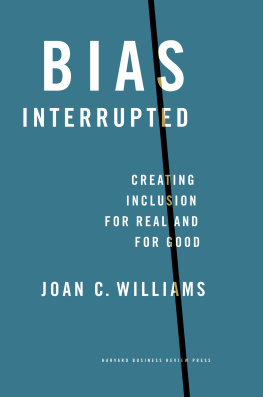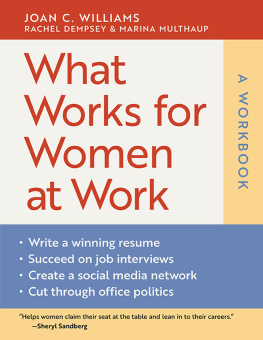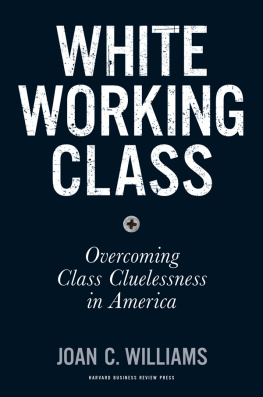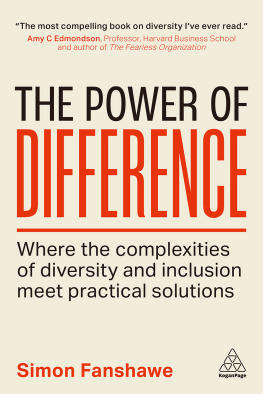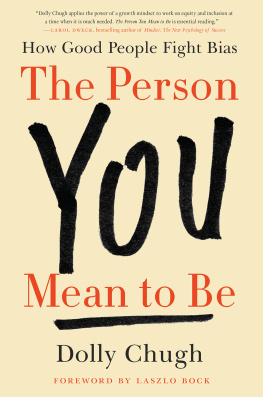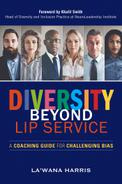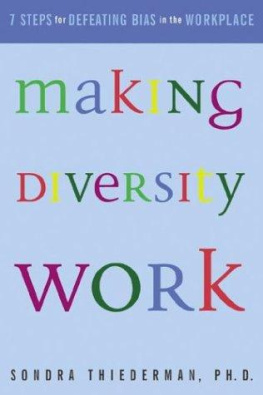Contents
Guide

ACKNOWLEDGMENTS
Every book is the product of community, and this one is no exception.
This book would not have been possible without the work of everyone who helped develop the Workplace Experiences Survey. The idea was Erika Halls when she was just a graduate student (shes now a business school professor at Emory), and I hired her to help me with the report Double Jeopardy? Gender Bias against Women of Color in STEM. She suggested adding a survey, which we did using lines of questioning I had developed in the interviews of my book What Works for Women at Work . I am eternally grateful to her, and to Kathy Phillips, who referred me to Erika and helped us with Double Jeopardy? Kathys untimely death in 2020 leaves us bereft of both a powerful scholar and a powerful spirit.
Professor Rich Lee also provided crucial help when we decided to add questions about racial stereotypes, given his expertise on Asian Americans.
Rachel Korn and Su Li, successive research directors at WorkLife Law, took the laboring oar in producing all the survey data presented here. They have been very patient with me!
When I wrote What Works for Women at Work , I had given up on the possibility of organizational change. I owe bias interrupters to Sarah Green Carmichael, my longtime editor at Harvard Business Review (now at Bloomberg), who insisted that I write an organizational change piece based on What Works for Women at Work . That became Hacking Techs Diversity Problem, edited by Sarah and published in HBR in 2014. Sarah also taught me the question-and-answer format of this book when she edited my last book, White Working Class . She edited this one, too, because I cant imagine writing a book without her.
I was equally lucky with my HBR Press editor this time, Scott Berinato, whose expertise in the graphical display of information was a truly invaluable contribution. Scott, my thanks to you for completely transforming the way I communicate complex data sets. You helped me express in stunningly simple terms something I have been trying to express for over a decade: how white mens experiences differ from those of every other group. And thanks for the editing, too!
Two of my board members, Elvir Causevic and Amber Lee Williams, both read through the entire manuscript and gave invaluable suggestions. Another board member, Laura Maechtlen, made important contributions to , and more generally to my understanding of race in America. My friend of half a century, Nino Magliocco, also contributed his experience as a CEOas did Elvir.
This book would not even have been remotely possible without my amazing research librarian Hilary Hardcastle. Nor would it have been without my team at WorkLife Law. Rachel Korn, our research director, is responsible for leading many of the studies based on the Workplace Experiences Survey, and for providing the quantitative expertise I lack. Mikayla Boginsky worked tirelessly with her usual phenomenal dedication and efficiency to get this manuscript out the door, aided by Joahna Cervantes. Julia Crawford worked for weeks scrubbing the footnotes. The remainder of the team at WorkLife LawChelsey Crowley, Jamie Dolkas, Juliana Franco, Jessica Lee, and Liz Morriskept things cooking while I was busy in another kitchen, as did Cynthia Thomas Calvert, my partner in crime for over twenty years.
Most of all I want to thank my family. My son, Nick Williams, defended his dissertation in the middle of this books writing, making him the first Dr. Williams in the history of our family. My daughter, Rachel Dempsey, with whom I wrote What Works for Women at Work , taught me most of what I know about how to write for a popular audience. My husband of forty-three years, James X. Dempsey, is my rock: he cheers me up when social inequality gets me down. I love them all very much.
APPENDIX
Methodology
The research on workplace bias described in this book comes from data collected using the Workplace Experiences Survey. The WES is a ten-minute survey designed to examine how bias based on gender, race/ethnicity, and social class plays out in everyday interactions in the workplace. Participants in each survey sample were asked to fill out quantitative questions in the WES while thinking about their current or most recent workplace, and also had the opportunity to write qualitative comments that are shared throughout this book.
Across fourteen different studies, approximately 18,000 participants have taken the WES. This includes nationwide studies of STEM professors and professionals, lawyers, engineers, architectural professionals, cross-industry professionals, and individuals at private organizations. These surveys are not nationally representative, although they do include individuals from across the United States as well as engineers in India. Due to the small number of men of color in our study of engineers, we do not report those results.
The WES seeks to ask about race/ethnicity in the most inclusive way, which has evolved over time. Therefore, some of the surveys discussed in this book use the term Asian Americans and some use people of Asian descent (which includes immigrants).
Quantitative WES data was collected using a 16 Likert scale: strongly disagree to strongly agree. Analyses examining differences in the experiences of different groups were conducted using one-way ANOVAs and regression analyses. Data is presented in the form of percentages of agreement for readers ease of understanding: 13 (strongly disagree to slightly disagree) is considered a response of no and 46 (slightly agree to strongly agree) is considered a response of yes.
ABOUT THE AUTHOR
JOAN C. WILLIAMS is a Distinguished Professor of Law, Hastings Foundation Chair, and Founding Director of the Center for WorkLife Law at the University of California, Hastings College of the Law. Described as having something approaching rock star status in her field by the New York Times Magazine , she has played a central role in reshaping the conversation about work and workplace bias over the past quarter century. Williams has authored 12 books and 115 academic articles, and she is the eleventh-most-cited scholar in her field. Her best-known prior books are White Working Class and What Works for Women at Work , coauthored with her daughter, Rachel Dempsey, and now in its tenth edition.
Williams has been on the forefront of research focused on how gender and racial bias play out in everyday workplace interactions for more than two decades and has coauthored a series of influential reports on workplace bias in engineering, academia, tech, architecture, and the legal profession. She is widely known for bias interrupters, an evidence-based, metrics-driven approach to eradicating implicit bias, which was introduced in the Harvard Business Review in 2014. The website www.biasinterrupters.org, with open-source tool kits for individuals and organizations, has been accessed more than 240,000 times from around the world and has been so influential in Europe that Williams was awarded an honorary PhD from Utrecht University in 2018.
Williams work is well-known among business leaders, HR professionals, and individuals. She has published thirty articles in Harvard Business Review , including one of the most-read articles in its one hundred-year history. Her TED talk, Why Corporate Diversity Programs Failand How Small Tweaks Can Have a Big Impact, has been viewed more than one million times, and videos she created for LeanIn.org about What Works for Women at Work were featured on Virgin Airlines as in-flight entertainment, seen literally around the world.
Awards include the Society of Women Engineers Presidents Award (2019), the Families and Work Institutes Work Life Legacy Award (2014), the American Bar Foundations Outstanding Scholar Award (2012), the American Bar Associations Margaret Brent Award for Women Lawyers of Achievement (2006), and the Distinguished Publication Award of the Association for Women in Psychology (2004; with Monica Biernat and Faye Crosby). In 2008, she gave the William E. Massey Sr. Lectures in the History of American Civilization at Harvard.

